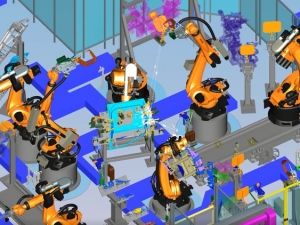PLC Programming
- Description
- Curriculum
- Reviews

-
1Introduction
The introduction of the PLC programming course. This lesson discusses what a PLC is and where it is used. Also, this lesson raises the question of the level of salaries for specialists in the field of controller programming. The lesson contains a short description of the entire course, what sections it consists of and what to expect from the course.
-
2PLC overview
This lesson includes a PLC overview: its history, architecture, PLC work cycle and standard programming languages. Lesson also discusses features of PLC programming within the IEC standard.
-
3PLC modules
In this lesson the PLC modules are discussed: what is the PLC consist of and what is the universal rack. The lesson highlights power supply, CPU, communication, functional and signal modules.
-
4PLC 300 series
Overview of PLC Simatic S7-300 series. Exactly this PLC series will be used during the course. The lesson covers the front interface of PLC, difference between other PLC series from Siemens and types of the controller.
-
5TIA Portal
This lesson includes the introduction of the TIA Portal: what is that and which tools it contains. Also, lesson describes main automation system design stages and gives an information about disadvantages of the TIA Portal.
-
6TIA Portal interface
This lesson gives some insight into the TIA portal interface: how to create a new project, add a new device and configure a device. This lesson shows project tree, device and instruction library and working areas of the TIA Portal window. In this lesson a simplest program for PLC was created.
-
7PLC configuration
Hardware configuration of controller device in TIA Portal and download configuration to the controller. The lesson contains instruction of how to connect PLC to a PC, and configure the device using all settings available in TIA Portal platform.
-
8Program blocks
The lesson includes description of what is the program blocks, its types, examples and main applications.
-
9Operands
Description of the main PLC memory areas and features of different operands used in user programs. Lesson contains examples for each data type.
-
10LAD
In this lesson one of the most popular programming language for PLC – Ladder diagrams or LAD is covered. Lesson includes the description of the main operations that can be used for user program.
-
11Timers
Lesson contains description of main types of timers. In the presentation examples of how to use different timers is shown.
-
12Counters
This lecture covers all the counter types that can be used for PLC programming.
-
13HMI Screens
The lesson contains the description of HMI panels, types of panel screens and the tasks HMI provides. In the lesson basic graphical components are being discussed as well.
-
14HMI Configuration
This lecture covers all the steps that is need to do to add a HMI device to the project in TIA Portal. In the lesson we take a quick look at basic settings for a HMI.
-
15Data loading to HMI
This lesson helps to quickly get through the process of loading the data to the HMI device.
-
16HMI animation
In this lesson HMI animations are being discussed. Lesson gives an overview of what types of animation are available for HMI panels and also lesson contains two examples of animation: appearance and movement.
-
17HMI alarms
This lecture gives basic idea of what alarm messages are and what types of messages do we have in PLC. In the lesson a little example of using the alarm messages was provided.
-
18Calculator
Practical lesson. Task: implement the mathematical addition of two numbers on a PLC. Use the toggle switches connected to the IB0 input as binary numbers. Use the LEDs connected to the QB0 input as the output of the addition operation. Use the toggle switch at input I1.0 for the command to load the first number into the controller's memory, the toggle switch at input I0.1 for the command to load the second number, and the toggle switch at input I0.2 for the command to display the result.
-
19Running light
Practical lesson. Task: Implement a running light on the PLC output module. Use the LEDs connected to QB0 as outputs. Provide a time delay of 1 s between the lighting up of two LEDs. With the help of the counter, ensure the counting of the number of complete cycles of the running light.
-
20Summary
The last lesson contains the summary of the course.


